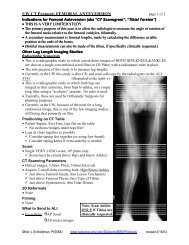Ankle and Foot 47 - Department of Radiology - University of ...
Ankle and Foot 47 - Department of Radiology - University of ...
Ankle and Foot 47 - Department of Radiology - University of ...
Create successful ePaper yourself
Turn your PDF publications into a flip-book with our unique Google optimized e-Paper software.
<strong>47</strong> <strong>Ankle</strong> <strong>and</strong> <strong>Foot</strong> 2229 <strong>47</strong><br />
Figure <strong>47</strong>-30. Tears <strong>of</strong> the anterior lateral ankle<br />
ligaments in a <strong>47</strong>-year-old. Straight axial protondensity<br />
(PD)–weighted (A) <strong>and</strong> T2-weighted fatsuppressed<br />
(B) images through the syndesmosis show<br />
disruption <strong>of</strong> the anterior tibi<strong>of</strong>ibular ligament (arrow).<br />
Straight axial PD-weighted (C) <strong>and</strong> T2-weighted fatsuppressed<br />
(D) images through the top <strong>of</strong> the ankle<br />
mortise show an interruption (arrowhead) <strong>of</strong> the<br />
anterior tal<strong>of</strong>ibular ligament.<br />
A<br />
B<br />
C<br />
D<br />
Medially, the ankle joint is stabilized by a group <strong>of</strong><br />
ligaments that fan out from the distal tip <strong>of</strong> the medial<br />
malleolus in a triangular configuration <strong>and</strong> collectively are<br />
called the deltoid ligament. When viewed in the coronal<br />
plane (Fig. <strong>47</strong>-31), the deltoid ligament can be seen to<br />
consist <strong>of</strong> deep fibers that insert on the medial process <strong>of</strong><br />
the talus <strong>and</strong> superficial fibers that insert on the calcaneus<br />
at the sustentaculum tali. Injuries <strong>of</strong> the deltoid ligament<br />
tend to be sprains* rather than complete ruptures, although<br />
they may be accompanied by bone marrow edema (Fig.<br />
<strong>47</strong>-32) or even avulsion fractures.<br />
Unlike the ankle tendons, which when visualized by<br />
MRI can be followed over a series <strong>of</strong> sequential slices in<br />
several planes, the ankle ligaments are usually seen on only<br />
*”Sprains” are defined as stretching or tearing <strong>of</strong> ligaments <strong>and</strong> are due to<br />
twisting injuries. “Strains” are defined as stretching or tearing <strong>of</strong> muscles, <strong>of</strong>ten at<br />
the musculotendinous junction, <strong>and</strong> are caused by sudden <strong>and</strong> powerful contractions<br />
or from overuse.<br />
one or two slices in a single imaging plane. And when they<br />
are seen in a piecemeal fashion on two images, it can be<br />
difficult to determine whether the two halves <strong>of</strong> the ligament<br />
are continuous. Certainly, seeing fluid extending<br />
through or around the ankle ligament helps confirm the<br />
diagnosis <strong>of</strong> a tear, but at the UW our sports medicine clinicians<br />
<strong>and</strong> orthopedic surgeons do not use MRI to evaluate<br />
the ankle ligaments. They rely on physical examination,<br />
<strong>and</strong> sometimes stress radiographs, to assess the functional<br />
integrity <strong>of</strong> the ankle ligaments, ordering MRI primarily for<br />
the bones <strong>and</strong> tendons.<br />
There are many accessory ossicles that can be present<br />
throughout the skeleton, <strong>and</strong> these are well documented<br />
in the encyclopedic text by Keats. 27 Many <strong>of</strong> these normal<br />
variants can be found in the feet. Three <strong>of</strong> the most commonly<br />
found accessory ossicles in the feet are the os trigonum<br />
posterior to the talus, the accessory navicular medial<br />
to the navicular bone, <strong>and</strong> the os peroneum plantar to the<br />
calcaneocuboid joint. Although in the vast majority <strong>of</strong><br />
people these are nothing more than asymptomatic inci-<br />
Ch0<strong>47</strong>-A05375.indd 2229<br />
9/9/2008 5:34:00 PM
















